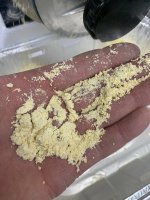J. James
In Bloom
There is so much BS in the worm game that purchasing quality products and learning about making your own castings can be quite confusing.
You'll see many advertisers using claims like:
"Pure Worm Castings"
"No manures or yard waste in the worm bedding and they are grain fed."
What I encourage you to do is ask some questions about how the worm castings are produced. Once you get a few questions answered I think you'll have a much better understanding of the quality of the product you are considering.
6 Questions to ask your worm guy:
1. What type of worms do you use?
2. What type of material are the worms fed?
3. How long are the worms left with the material to make the castings?
4. What type of "Worm Feed" are you using to supplement their diet?
5. How long have you been in the Worm Casting business?
6. How long has the ready to purchase product sat around?
7. Are they 100% Pure Castings? (Run if they say yes)
Red Flag Answers: If you get several of these red flag answers I would avoid using the product.
Question #1: Canadian Nightcrawlers, African Nightcrawlers, European Nightcrawlers. Many times when you get this as the first answer you are dealing with a business that uses small black plastic buckets with Black Peat, worms and an indoor temperature controlled facility. None of which are great for the environment, and all of which end up with a low-quality casting material that looks like pure castings. Note: Many reputable worm farmers will use European Nightcrawlers and the type of worm used on its own doesn't mean much. I do find it strange that many of these dealers label their worms as "Canadian Nightcrawlers" which are in fact just Lumbricus Terrestris or normal European Nightcrawlers.
Question #2: If you hear peat moss or black peat, or "No Manure and no waste" then RUN the other way. Worms best use is to recycle waste materials and the best way to feed worms is with plant-based thermophilic compost which is often times a manure-based compost. This way you deal with a waste problem while creating a new product. If your worm farmer is shipping peat moss all over the world just to make castings then they are not doing it right and the peat moss isn't enough food so they will have to add "grains" or worm chow products.
Question #3: If you get a response with something like, "14 days" or "Not Long" or "A couple of weeks" then you should look elsewhere for your materials. Good vermicompost is typically made with a minimum of 45-60 day retention times and sometimes longer that way the worms can properly work the product.
Question #4: If the worm farmer says they feed with grains, this typically means a chicken mash type feed or a Purina Worm Chow type of feed. Worm farmers typically use this feed to fatten worms up for sale and also to supplement the Black Peat Moss they are feeding the worms. The black peat moss works great for the production because the lack of nutrients keeps the pile of peat from going thermal and killing the worms.... but it doesn't have any nutrition so the farmer is forced to use worm feed. Again, why we ever want to Purchase goods to feed worms when the whole idea is for the worms to process waste products and produce? When worms are fed plant-based materials from compost they are getting much more than nutrients. There are plant growth hormones and other benefits that are of primary importance when using finished vermicompost. Don't cheat yourself and use castings that were raised off of Peat and Grains, that might be fine to produce a fat worm for your fishing hook, but not for creating diverse finished vermicompost.
Question #5: If they just started the business a few months ago and have purchased a "Franchise" model for creating perfect pure castings every time.... you want to stay away! These new companies are purchasing a business model that is built off of the Peat Based, Plastic Bucket Housed, Grain fed worm systems. Anyways, not all new businesses should be avoided, but the ones using the same model from these major worm companies should be avoided because the end goal is to churn out a Pure Casting product every 2 weeks and feed them imported peat moss. That is not how castings should be made!
Question #6: If the worm farmer says.... well that is last years castings.... stay away! Storing Vermicompost can be done but you want to avoid the Pre-Bagged worm castings from your hydroponic store that has had the same inventory for 6 months left over from last season... This will be a waste of money. You can get a decent product that has sat around a few months as long as it was stored in bulk with good moisture content.
Question #7: If the worm farmer is basing his High Dollar Price off of the fact that they only sell 100% pure castings you should look the other way. Some of these businesses understand that it's a ridiculous claim to make so they end up playing it safe and saying 99% castings. Who decided it was 99%? Some microscope lab? How would you know if the Black Peat looks exactly the same as the castings? These companies are practically starving worms so they can re-ingest the same material over and over again to make an end product that is closer to pure castings. The problem is that most of these companies aren't "screening" out the pure castings. Instead, they are feeding with black peat that looks almost identical to worm castings before it's even fed to the worms. Might as well just by the peat moss and save some money.

